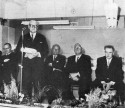Factory Expansion
 FIFTEEN years to grow from a £700, threeman enterprise to a £230,000 corporation employing 250 - that is the story of Bell Radio. A large new factory opened this year, and a 1963 profit nine times higher than the 1962 level, are symbols of the remarkable achievement of this remarkable company.
FIFTEEN years to grow from a £700, threeman enterprise to a £230,000 corporation employing 250 - that is the story of Bell Radio. A large new factory opened this year, and a 1963 profit nine times higher than the 1962 level, are symbols of the remarkable achievement of this remarkable company.
Mr. Al Bell, the founder and present chairman, had hearing aids - not radios - in mind when he and two partners began it all in a back street room in September 1948. Radio manufacturers of the time said that, with a total production of 48,000 sets a year, their market was saturated.
But Mr. Bell saw the real trouble, which was not market saturation but prices that were too high in a market with limited purchasing power. His company forgot about hearing aids. It made radios - not in hundreds like other manufacturers, but in thousands, and with prices slashed to suit. Its Antone battery portable, first of its kind in New Zealand, took the company straight to the top of the portable field.
Now in larger premises in Queen Street, Bell Radio applied the same principles to first the mantel radio, then the radiogram, then the transistor portable, with similar results. Its Colt mantel radio, produced in runs of 5000 sets -and £5/5/- cheaper than its nearest competitor - went into 160,000 New Zealand homes. Its Truetone radiogram, at the unheard-of price of £69/10/-, was a huge seller for several years. And its Bell transistor portable, first on the market, achieved an equally spectacular result.
Then followed the hard years. With Tv. a shadowy image on the horizon, radio sales declined. But there was no Tv. programme, and no sign that one was immediately forthcoming. In 1957, Bell started its own transmissions and, by building public interest in the medium, established a favourable climate for television's official introduction.
A public company since 1957, Bell Radio has forged ahead rapidly since Tv. caught the public fancy in 1962. After a nett loss in 1960 the company made an encouraging profit of £13,833 in 1962 - then a whopping £127,000, tax-paid, in 1963. As well as compensating shareholders for the leaner years, this has allowed Bell to buy the Dominion Road premises which it formerly rented and to build on an adjoining site the extensive new factory illustrated below.
Now established in the new plant, the company is firmly based for future progress. Its range of Tv. is wider than, and its sales at least as great as, any of its New Zealand competitors. It has successfully introduced to New Zealand the General range of radios, made under an agreement which the new general manager, Mr. Lou Reindler, negotiated on a visit to Japan in 1961.
And, with the whole vast field of electronics so far largely unexplored - let alone exploited - there is no visible limit to the company's future progress. As Mr. Al Bell says: "So long as there's a new product, or a new method, to be introduced in electronics, this company will continue in the forefront of the New Zealand electronics industry."
THREE times the size of the former facilities, Bell's new plant at 274 Dominion Road is the most modern in the New Zealand industry. Its production is in one continuous flow, picking up components from the unloading point, carrying them through successive assembly stages and finally depositing the packed, addressed goods at the outward loading bay - all in one smooth, unrippled stream.
Automatic methods have replaced manual ones wherever possible. Electric hoists carry components from the stores to the production lines. A chain conveyor carries Tv. and radio chassis between departments. Wiring benches are equipped with rollers to move each chassis from one operator to the next. Roller conveyors handle Tv. from chassis assembly, through the nine test bays, through two hours of soak test, right to the spot where they are packed for dispatch - one yard exactly from the goods exit.
Such efficiency does more that eliminate handling, and the waste and risk of damage which handling entails. Coupled with rigorous checking at all stages of manufacture, it ensures that every Bell or General set produced is exactly the same as its neighbours - the same unvarying standard of excellence on which Bell's reputation was first founded.



